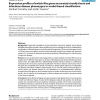Free Online Productivity Tools
i2Speak
i2Symbol
i2OCR
iTex2Img
iWeb2Print
iWeb2Shot
i2Type
iPdf2Split
iPdf2Merge
i2Bopomofo
i2Arabic
i2Style
i2Image
i2PDF
iLatex2Rtf
Sci2ools
117
Voted
BMCBI
2008
2008
Expression profiles of switch-like genes accurately classify tissue and infectious disease phenotypes in model-based classificat
Background: Large-scale compilation of gene expression microarray datasets across diverse biological phenotypes provided a means of gathering a priori knowledge in the form of identification and annotation of bimodal genes in the human and mouse genomes. These switch-like genes consist of 15% of known human genes, and are enriched with genes coding for extracellular and membrane proteins. It is of interest to determine the prediction potential of bimodal genes for class discovery in large-scale datasets. Results: Use of a model-based clustering algorithm accurately classified more than 400 microarray samples into 19 different tissue types on the basis of bimodal gene expression. Bimodal expression patterns were also highly effective in differentiating between infectious diseases in model-based clustering of microarray data. Supervised classification with feature selection restricted to switchlike genes also recognized tissue specific and infectious disease specific signatures in indep...
| Added | 09 Dec 2010 |
| Updated | 09 Dec 2010 |
| Type | Journal |
| Year | 2008 |
| Where | BMCBI |
| Authors | Michael Gormley, Aydin Tozeren |
Comments (0)

